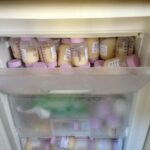Breastfeeding is one of the most rewarding but challenging tasks many mothers will go through. Beyond initially coming to grips with how to care for your new tiny human, figuring out a comfortable latch can be a make or break for some breastfeeding journeys.
This is the reason why a lot of mothers choose to exclusively pump their breastmilk to provide for their babies. But many women have issues when pumping such as elastic nipples.
We have put together some great tips to make pumping with elastic nipples pain-free.
Elastic Nipple Symptoms
For many moms, it can feel really disheartening when you can’t pump enough milk to provide for your baby. What many don’t realize is they may be suffering from elastic nipples!
A simple way of checking is to look in the flange as you’re pumping and pay attention to how far your breast tissue gets sucked in. If your nipple and breast reach further than halfway down the flange tunnel, you may have elastic nipples. Other symptoms may be:
- pain and discomfort during & after pumping sessions
- frequently clogged breasts
- mastitis
- cracked nipples
What Causes Elastic Nipples?
If you’re reading this and finding similarities to your pumping experience, you might be wondering what could have caused this. But rest assured, it is totally common and normal to have more elasticity in your breast tissue after pregnancy.
The same hormones that were responsible for stretching your belly to accommodate that gorgeous growing bump are present in your breasts too!
If you’re not too sure whether you have elastic nipples or not, you can always consult the International Board of Lactation Consultant Examiners or IBCLC as they are known for short for more information and support on your journey.
Elastic Nipple Solutions
Here are a few methods for you to try at home. One answer may work better than others so be sure to keep trying until you find a comfortable fit for you. Remember, no two boobs are the same and there are so many variations of nipples, areolas, shapes, sizes, and colors out there.
1. Coconut Oil
Coconut oil is a great way to help bring comfort to your pumping sessions, without forking out on a new pumping system.
It helps to lubricate between your breast and the flange, creating less friction when you pump for longer periods of time. It’s also a great method used to heal cracked and sore nipples, so you can have multiple benefits at once!
As long as you use an unrefined organic version, it is also perfectly safe for your baby to consume, so no need to worry about wiping it off afterward.
Prices pulled from the Amazon Product Advertising API on:
Product prices and availability are accurate as of the date/time indicated and are subject to change. Any price and availability information displayed on [relevant Amazon Site(s), as applicable] at the time of purchase will apply to the purchase of this product.
2. Purchase A New Flange
If you find your nipple is rubbing along the flange when pumping no matter how hard you try to reposition, you may need a wider flange.
Often, the manufacturers of your pump will be more than willing to help you find a better-suited fit for your breast shape.
3. Try Breast Pump Cushions
Breast pump cushions help to relieve discomfort if you are experiencing sensitivity when pumping, and maybe another method you wish to try in order to help with a more comfortable pump.
They help to create a barrier between your pump and breast, which should make it easier to pump for longer periods of time.
It is important to find a type that fits well for your breast pump brand, otherwise, this will create too much slack and movement which may break the suction around your breast when the milk is being removed.
Prices pulled from the Amazon Product Advertising API on:
Product prices and availability are accurate as of the date/time indicated and are subject to change. Any price and availability information displayed on [relevant Amazon Site(s), as applicable] at the time of purchase will apply to the purchase of this product.
4. Adjust Your Suction Strength
All pumps will have a customizable strength option to comfortably fit your breast best. If you are finding it painful and uncomfortable to pump, you may want to lower the suction of your pump to fit comfortably.
Alternatively, if you don’t feel you have enough suction to effectively drain the breast you may want to increase the suction level.
Many personal use pumps have a suction level of up to 200 mmHg, but hospital-grade pumps go up to the 300 mmHg range if you feel you need more power to pump.
5. Relax
It’s so easy to get tense and stressed when your pumping just isn’t going to plan. Focus on your posture and make sure you’re not hunched forward and tense.
Relax your shoulders and try not to focus on the time you’ve spent pumping, this will only worsen your anxiety. Some moms find it useful to place a cloth over the pump so they don’t find themselves focusing on how much/ little milk output they are getting.
How To Measure Your Nipple Size
View in gallery
The key to getting a great start to your pumping journey is all about having the right tools. It is important you use your breast pump with the best possible fit, starting with the right-sized flange to fit your nipple.
This will make sure your pumping sessions are comfortable and efficient too, removing the most milk possible and avoiding any nasty clogged ducts or mastitis.
You will need a ruler OR measuring tape
- Make sure you’re sitting comfortably to get the most accurate measurement possible.
- Using your chosen measuring device, measure the distance straight across the middle of your nipple at the base, in millimeters. Remember, 1cm=10mm. Do not include the areola around your nipple as this will give you too large of a measurement.
- Add 4mm to your figure. So if your nipple was 20mm, you would now use 24mm as your final measurement.
- This will give you the flange size you need! It is important to size up, so if your final measurement is 32mm, you’d get a 33mm flange.
Most breast pump manufacturers have a team designed to help you find the right fit, so if you have any doubt, reach out and they will be able to tell you what sized flange works best for your nipple based on your measurements!
Tips For Successful Pumping
With so much information out, it can be hard to know with elastic nipples what will work for a great pumping session. Here are some of our top tips to help you pump with elastic breast tissue.
As we just covered, it is vital you have the correct flange size on your breast pump, the right size will make a massive difference to your milk output, comfort, and overall pumping experience.
You should make sure to measure your nipples regularly if you plan to pump on a long-term basis for your little one. Remember how much your boobs changed during pregnancy? This is no different!
If you’re getting increasingly uncomfortable during pumping sessions, then maybe consider re-measuring.
It’s totally normal for women to have breasts with different measurements, so you may need 2 different flange sizes for each breast to ensure pumping with elastic nipples is successful.
Unless you are exclusively pumping, the key to maintaining a great milk supply for your little one is frequent nursing.
View in gallery
Your breasts will only make more milk if they are being frequently drained, so limit the amount of formula you give if you top-up as this will affect your supply and cause a decrease.
The right pump is key when it comes to pumping with elastic nipples. Did you know you can usually get a breast pump for FREE through your health insurance policy?
Make sure to do your research and ask the right questions, but thanks to the Affordable Care Act most policies will cover your cost for a breast pump.
Maybe you’re back in work, or just couldn’t quite get a good latch, remember exclusive pumping is no joke and you should be so proud mom!
Frequent pumping or power-pumping means your breasts are frequently getting drained, signaling the need to make more milk and therefore upping your supply!
Electric pumps will be much easier for you in the long term, but manual ones can sometimes be easier to transport if you just need a quick comfort pump.
If possible, relax and find a quiet comfortable spot to pump (we know this is rare as a mom!). Maybe you can have some of your baby’s clothing with you to sniff and get those hormones flowing and increase milk let down?
Remember mom, you can’t pour from an empty cup so make sure you are looking after yourself too! A healthy diet with variation, plenty of water, and exercise will make the world of difference to pump more breastmilk.
Seek Professional Help
Whether you’re exclusively pumping or just want to pump a spare stash for a couple of hours of freedom, you need to make sure you properly drain the breast with a comfortable pumping system that works well for you.
Many moms buy a pump and expect a one-size-fits-all type of experience, however, making sure the flange is the correct size to fit your nipple and areola is the secret to a good pumping session.
You should find your nipple sits comfortably in the middle of the flange and doesn’t press against the sides, equally you should have a comfortable amount of areola within the pump, but not so much that you find the tissue is getting compressed from the suction.
If all fails and you are still having issues pumping then it is time to seek some professional help and advice.
If you feel it would help, IBCLC’s are always available to help as well as your local pediatrician. The American Academy of Pediatrics also has some really useful information you can seek.
View in gallery
FAQs
Is pumping bad for your breasts?
If you pump too much, you may increase your milk supply too much which if not effectively drained, could lead to blocked ducts or mastitis which can be serious if left untreated.
How can I heal my sore nipples?
Many moms find lanolin ointments and moist cloths help to alleviate pain when your nipples get sore. Lanolin is a great way to promote moist wound healing, as it reduces the water lost through the skin from up to 20-30%.
This means your nipples will not dry out and become too uncomfortable after feeding or pumping sessions.
Prices pulled from the Amazon Product Advertising API on:
Product prices and availability are accurate as of the date/time indicated and are subject to change. Any price and availability information displayed on [relevant Amazon Site(s), as applicable] at the time of purchase will apply to the purchase of this product.
What happens if my breast pump flange is too small?
If you continue to use a flange that doesn’t have an effective fit to your breast, this in time will affect your milk production as you will not get proper milk drainage from the breast. It is important you find the right fitting flange for you.
The Final Thought
Without a doubt, breastfeeding can be a difficult process for new moms and it makes you pay attention to parts of your body that you may not have really given much thought to before now – such as the elasticity of your nipples!
Many women have breastfeeding issues but most can be solved with the right equipment and some professional help.
Remember pumping and breastfeeding should not be painful, don’t push your body by using the highest strength suction if it is causing you pain and discomfort.









